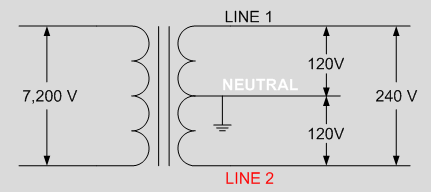Martin, I'm looking for precise mash temp control - so we would 'need' the PID - as well as a somewhat manual boil control - the rheostat.
I personally think that the High Gravity design is a bit of a hack. If you want PID control and easy manual control, what you really want is a PID and the unit that Martin has linked. All you need to do is to use a double-pole double-throw switch between the +/- control output connections on both units and the +/- control inputs of the SSR.
You are more than smart enough to wire to up a simple control unit, especially a 120V system because only the black (hot) wire needs to be switched. By code, the white (neutral) is bonded to ground at the distribution panel (a.k.a. fuse or breaker box). U.S. power is 240 split-phase. A transformer outside of your home steps the distribution voltage from 7.2K Volts AC down to 240 Volts AC. If your subdivision is fed with underground wires, the transformer will be on the ground in someone's yard or in a common area. In older areas that are fed by overhead lines, the step-down transformer is on a pole.
The step-down transformer has three secondary winding taps that feed your home; namely, two hot legs that are the ends of the secondary winding and a wire that is located mid-way on the secondary winding known as the center-tap. The center-tap is what becomes the white wire after power service enters your home. It is the zero crossing for the AC power signal, which is a sine wave (thanks to Nikola Tesla). The voltage delta between the coil ends (hot legs) is 240 volts. The voltage delta between center-tap and either of the hot legs is 120V. If we run a circuit that consists of only the center-tap and one of the hot legs, we obtain a 120V circuit that is 1/2th of the sine wave, which is why the power distribution system is known as split-phase.

Here's where anyone who is considering using a 120V BoilCoil needs to be careful. The most common "branch" circuit in a home is 120V 15A. One cannot plug a 2250W BoilCoil into a 15A circuit. The electrician who wired your home should have labeled the branch circuits inside of the distribution panel (breaker box). Identify the circuit that you plan to use, and then check the number on the breaker. Unless it says 20, the circuit cannot be used for a 120V BoilCoil-equipped kettle. Furthermore, one has to be careful that a previous owner has not replaced a 15A breaker with a 20A breaker without upgrading the wire. A 20A circuit requires 12AWG wire. Fifteen amp circuits are wired with 14AWG, which can overheat when one attempts to draw more than 15A. AWG sizing works the opposite way that people think. The higher the number, the smaller the diameter. The smaller the diameter, the higher the resistance.
With that said, there are usually two branch circuits that are almost guaranteed to be 20A circuits. The first circuit is the one for one's washing machine. It will usually be a single receptacle where one of the slots looks like a "T" turned on it's side. If the circuit is wired to code, that type of receptacle indicates the circuit is capable of carrying 20A. The other circuit is often labeled "Kitchen Circuit." This circuit is usually wired to the receptacles that line one's kitchen counter top. It will also usually have GCFI breakers. If your kitchen circuit is 20A, and you want to use it to power a BoilCoil, you should upgrade the GFCI receptacles on this circuit to 20A GFCI receptacles.
http://www.homedepot.com/p/Leviton-SmartLockPro-20-Amp-Slim-GFCI-Duplex-Outlet-White-R02-N7899-0KW/203427638
By the way, the 2250W BoilCoil does not draw 2250W of power on a good day. My 2250W BoilCoil has a resistance of 7.1 Ohms. Power equals voltage multiplied by current. In this case, we only know the line voltage and the coil
resistance; however, we can use Ohm's law to determine the current.
P (watts) = E (voltage) * I (current)
I (current) = E (voltage) / R (resistance)
Therefore
P (watts) = E (voltage) * E (voltage) / R (resistance)
E = 120
R = 7.1
P = 120 * 120 / 7.1 = 2,028W
The 2250W BoilCoil actually draws 2,028 / 120 = 16.9 amps of current.